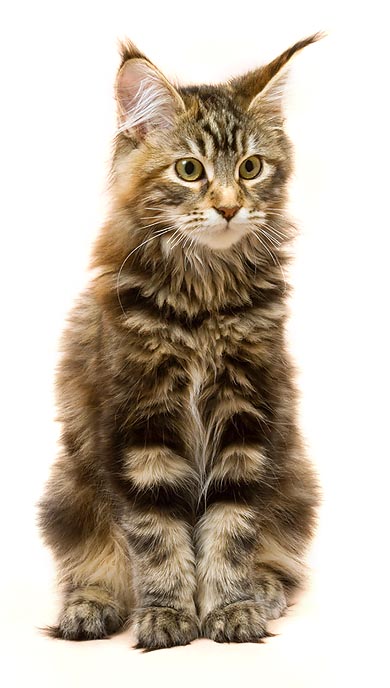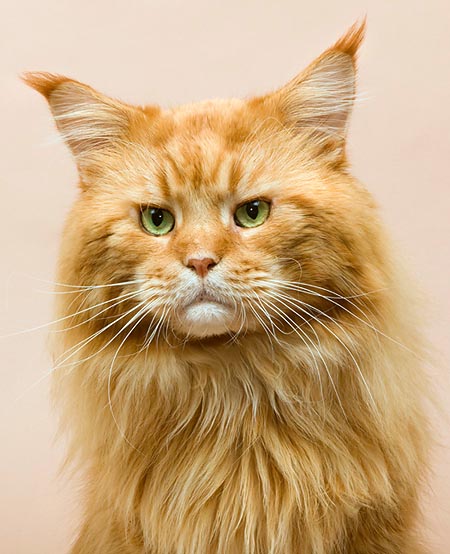Family : Felidae

Text © Dr Didier Hallépée

English translation by Mario Beltramini

Maine Coon © Giuseppe Mazza
After having left the banks of the Nile for settling in Europe, the cat has quite simply followed the pioneers in the conquest of the New World, where it has adapted to the different habitats available.
After a folk tale, some of them have crossed, in depths of the Maine forests, with raccoons, thus originating a feline big sized species whose colour reminded that of its ancestor. It is clearly impossible, but it is from there that its name “Coon” comes, name which, later on, was prolonged to Maine Coon.
After another legend, Marie-Antoinette, scared by the revolution, had thought to take shelter in the United States. The lesson of Varennes had been understood, as her fly was better organized. She was able to handover her six
Turkish Angoras to Capt. Clough of the vessel she had to join. The flight never took place, and the Angoras found themselves alone in the house foreseen for the queen, close to the state of Maine. The Main Coon should be a descendant of these cats.
Another tale narrates that the Main Coon comes from the cats which travelled with the Vikings by the year 1000 during their explorations of the New World.
Whatever its origin is, the Main Coon is a remarkable adaptation of a race of cats with semi-long hair to the specific conditions of the Maine forests which have caused the changes necessary for better profiting of their habitat, rendering it the biggest cat of breed.
The first Maine Coon, Captain Jencks, was presented at the expositions of Boston and New York in 1881. Little by little, the Maine Coon had to pass over the boundaries of the state for then falling into oblivion and to re-emerge from this during the fifties. It was recognized as a breed in 1967. The introduction of the Maine Coon in France dates from 1981, but the breed became popular in the early nineties only.
Character
The Maine Coon is the biggest domestic cat. It can weigh even 11 kg (without being obese, of course). Solidly built and with a rustic appearance, the Maine Coon is qualified as a gentle giant.
Very sociable, it likes the kids and also other animals. It is playful, good hunter, sporting and very affectionate to its masters. It is qualified also as “cat-dog”, being able to bring back a toy in order to have it thrown again. Willingly accepts a short walk at leash. Males are clearly more imposing than the females.
Standard
The head is of good size, both in length and width, with high and salient cheek-bones. Seen from the side, the line of the nose forms a slightly concave bend without stop. The skull is slightly rounded.
From the front, the muzzle looks squared, whilst, when seen from the side, it distinctly stands out from the skull and is never either sharp or narrow. The nose, lips and the tip of the chin are aligned on the same vertical thus increasing the “squared” impression of the muzzle. The chin is firm and powerful. The balance of the proportions between head and length of the muzzle is essential.
Big, slightly oval and well spaced, the eyes are placed obliquely but may seem round when the cat is vigilant. All tones of green, golden, copper or yellow are accepted even if there is no relation between the colour of the eyes and that of the mantle. The blue eyes or un-matching are accepted in the white cats.

Maine Coon Red Blotched Tabby © Giuseppe Mazza
Big, wide at the base, placed high on the head (see tolerances), the ears are separated between them by a space equivalent to the width of the base of one ear. Moderately sharp, they are slightly bent outwards. They are well haired and lynx tips are desirable.
Medium sized, the neckline is well muscled. Long and powerful, the body is big, well muscled and with a broad chest. Rectangular, it must not, any way, show any exaggeration which might cause harm to the general balance.
Solid, with a powerful musculature and a strong bone frame, the paws are averagely high, and this increases the rectangular look of the body.
Big and round, with five fingers ahead and four back, the feet have an important inter-digital hair.
Long, the tail must ideally reach the base of the scapula. Wide at the base, it is particularly well furnished of long hairs which form soft locks and ends with a tip.
Short on shoulders and thighs, the fur gets gradually longer on the sides for reaching its full length on the belly and the rear. Sought for under the throat, the collar does not spread on the chest. The texture is silky but firm and falls naturally on each side of the body. The down-hair is thin. The length of the fur and the thickness of the down-hair vary depending on the seasons and a mantle clearly shorter in summer must not be penalized by the judgement.
Coat
All the colours, but chocolate, lilac, cinnamon and fawn.
→ For general notions about Felidae please click here.
→ To appreciate the biodiversity within the CAT BREEDS please click here.
